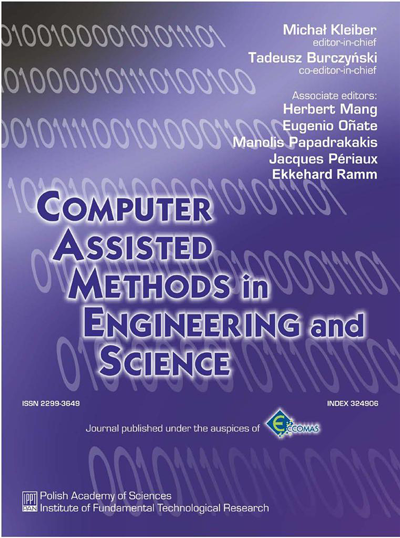Numerical procedure of solving some inverse problem in solidification of the binary alloy
Abstract
The paper presents a solution of an inverse problem consisting in determination of boundary conditions in the process of binary alloy solidification when temperature measurements in selected points of the cast are known. In the investigated model the distribution of temperature is described using the Stefan model with the liquidus temperature varying in dependance on concentration of the alloy component. For description of the concentration we apply the model in which the immediate equalization of chemical composition of the alloy is assumed (lever arm model). Experimental verification of the developed algorithm is also presented.
Keywords
solidification, segregation, binary alloy, genetic algorithm,References
[1] V. Alexiades, A.D. Solomon. Mathematical Modeling of Melting and Freezing Processes. Hemisphere Publ. Corp., Washington, 1993.[2] A. Bokota. Modelling of solidification and cooling of two-component metal alloys, fields of temperature, concentrations and stresses [in Polish: Modelowanie krzepnięcia i stygnięcia dwuskładnikowych stopów metali. Pola temperatury, stężeń i naprężeń]. Wyd. Pol. Częstochowskiej, Częstochowa, 2001.
[3] J. Crank. Free and Moving Boundary Problems. Clarendon Press, Oxford, 1996.
[4] J.D. Foley, A. van Dam, S.K. Freiner, J.F. Hughes, R.L. Phillips. Computer Graphics – Principles and Practice. Addison-Wesley, San Diego, 1990.
[5] E. Fraś. Crystallization of metals [in Polish: Krystalizacja metali]. WNT, Warszawa, 2003.
[6] B. Ganapathysubramanian, N. Zabaras. Control of solidification of non-conducting materials using tailored magnetic fields. J. Crystal Growth, 276: 299–316, 2005.
[7] B. Ganapathysubramanian, N. Zabaras. On the control of solidification using magnetic fields and magnetic field gradients. Int. J. Heat Mass Transfer, 48: 4174–4189, 2005.
[8] S.C. Gupta. The Classical Stefan Problem. Basic Concepts, Modelling and Analysis. Elsevier, Amsterdam, 2003.
[9] W. Kapturkiewicz, E. Fraś, A.A. Burbelko. Modeling the kinetics of solidification of cast iron with lamellar graphite. Arch. Metall. Mater., 54: 369–380, 2009.
[10] W. Kurz, D.J. Fisher. Fundamentals of Solidification. Trans Tech Publ., Zurich, 1989.
[11] E. Majchrzak, B. Mochnacki. Application of the BEM in the thermal theory of foundry. Eng. Anal. Bound. Elem., 16: 99–121, 1995.
[12] E. Majchrzak, B. Mochnacki, J.S. Suchy. Sensitivity analysis of macrosegregation simulation with respect to partition and diffusion coefficients. Int. J. Cast Metals Research, 17: 72–78, 2004.
[13] E. Majchrzak, R. Szopa. Simulation of heat and mass transfer in domain of solidifying binary alloy. Arch. Metallurgy, 43: 341–351, 1998.
[14] B. Mochnacki, E. Majchrzak, R. Szopa. Simulation of heat and mass transfer in domain of casting made from binary alloy. Arch. Foundry Eng., 8(4): 121–126, 2008.
[15] B. Mochnacki, J.S. Suchy. Numerical Methods in Computations of Foundry Processes. PFTA, Cracow, 1995.
[16] B. Mochnacki, J.S. Suchy. Simplified models of macrosegregation. J. Theor. Appl. Mech., 44: 367–379, 2006.
[17] B. Mochnacki, J.S. Suchy, M. Prażmowski. Modelling of segregation in the process of Al-Si alloy solidification. Soldification of Metals and Alloys, 2(44): 229–234, 2000.
[18] R. Parkitny, T. Skrzypczak. Simulation of solidification of two-component metal alloys taking the admixture distribution under consideration [in Polish: Symulacja krzepnięcia dwuskładnikowych stopów metali z uwzględnieniem rozkładu domieszki]. Arch. Foundry, 2(4): 198–203, 2002.
[19] D. Samanta, N. Zabaras. Numerical study of macrosegregation in aluminum alloys solidifying on uneven surfaces. Int. J. Heat Mass Transfer, 48: 4541–4556, 2005.
[20] D. Samanta, N. Zabaras. Control of macrosegregation during the solidification of alloys using magnetic fields. Int. J. Heat Mass Transfer, 49: 4850–4866, 2006.
[21] C.A. Santos, J.M.V. Quaresma, A. Garcia. Determination of transient interfacial heat transfer coefficients in chill mold castings. J. Alloys and Compounds, 319: 174–186, 2001.
[22] N. Sczygiol. Numerical modelling of thermo-mechanical phenomena in a solidifying casting and a mould [in Polish: Modelowanie numeryczne zjawisk termomechanicznych w krzepnącym odlewie i formie odlewniczej].Wyd. Pol. Częstochowskiej, Częstochowa, 2000.
[23] D. Słota. Solving the inverse Stefan design problem using genetic algorithms. Inverse Probl. Sci. Eng., 16: 829–846, 2008.
[24] D. Słota. Identification of the cooling condition in 2-D and 3-D continuous casting processes. Numer. Heat Transfer B, 55: 155–176, 2009.
[25] D. Słota. Restoring boundary conditions in the solidification of pure metals. Comput. & Structures, 89: 48–54, 2011.
[26] J.S. Suchy. Segregation of alloying elements during directional solidification [in Polish: Segregacja pierwiastków stopowych podczas krzepnięcia kierunkowego]. Zeszyty Nauk. Pol. Śl. Mech., 76: 1–132, 1983.
[27] J.S. Suchy. Segregation of alloying elements in continuous casting technology [in Polish: Segregacja pierwiastków stopowych w technologii ciągłego odlewania]. Zeszyty Nauk. Pol. Częstochowskiej Hut., 19: 169–180, 1988.
[28] J.S. Suchy, B. Mochnacki. Analysis of segregation process using the broken line model. Theoretical base. Arch. Foundry, 3(10): 229–234, 2003.
[29] R. Szopa. Modelling of solidification and crystallization using combined boundary element method [in Polish: Modelowanie krzepnięcia i krystalizacji z wykorzystaniem kombinowanej metody elementów brzegowych]. Zeszyty Nauk. Pol. Śl. Hut., 54: 1–175, 1999.
[30] V.R. Voller. A similarity solution for the solidification of a multicomponent alloy. Int. J. Heat Mass Transfer, 40: 2869–2877, 1997.
[31] V.R. Voller. A numerical method for the Rubinstein binary-alloy problem in the presence of an under-cooled liquid. Int. J. Heat Mass Transfer, 51: 696–706, 2008.
[32] D. Xu, Q. Li. Numerical method for solution of strongly coupled binary alloy solidification problems. Numer. Heat Transfer B, 20: 181–201, 1991.
[33] G.Z. Yang, N. Zabaras. The adjoint method for an inverse design problem in the directional solidification of binary alloys. J. Comput. Phys., 140: 432–452, 1998.
[34] M. Založnik, S. Xin, B. Šarler. Verification of a numerical model of macrosegregation in direct chill casting. Int. J. Numer. Methods Heat Fluid Flow, 18: 308–324, 2008.
Published
Jan 25, 2017
How to Cite
HETMANIOK, Edyta; SŁOTA, Damian.
Numerical procedure of solving some inverse problem in solidification of the binary alloy.
Computer Assisted Methods in Engineering and Science, [S.l.], v. 19, n. 4, p. 393-402, jan. 2017.
ISSN 2956-5839.
Available at: <https://cames.ippt.gov.pl/index.php/cames/article/view/89>. Date accessed: 31 may 2025.
doi: http://dx.doi.org/10.24423/cames.89.
Issue
Section
Articles




